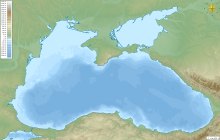| Battle of Sinop | |||||||
|---|---|---|---|---|---|---|---|
| Part of the Crimean War | |||||||
 The Battle of Sinop by Alexey Bogolyubov | |||||||
| |||||||
| Belligerents | |||||||
|
| |||||||
| Commanders and leaders | |||||||
|
|
| ||||||
| Strength | |||||||
|
6 ships of the line, 2 frigates, 3 steamers [2] |
7 frigates, 3 corvettes, 2 steamers [2] | ||||||
| Casualties and losses | |||||||
|
37 killed, 229 wounded[3] |
3,000 killed[3] 1 frigate sunk, 1 steamer sunk, 6 frigates grounded, 3 corvettes grounded, ~2 shore batteries destroyed[4] | ||||||
Location within Black Sea | |||||||
The Battle of Sinop, or the Battle of Sinope, was a naval battle that took place on 30 November 1853 between Imperial Russia and the Ottoman Empire during the opening phase of the Crimean War (1853–1856).[5] It took place at Sinop, a sea port on the southern shore of the Black Sea (the northern shore of Anatolian Turkey).[5] A Russian squadron attacked and decisively defeated an Ottoman squadron anchored in Sinop's harbor. The Russian force consisted of six ships of the line, two frigates and three armed steamers, led by Admiral Pavel Nakhimov; the Ottoman defenders were seven frigates, three corvettes and two armed steamers, commanded by Vice Admiral Osman Pasha.[1][5]
The Russian navy had recently adopted naval artillery that fired explosive shells, which gave them a decisive advantage in the battle. All the Ottoman frigates and corvettes were either sunk or forced to run aground to avoid destruction; only one steamer escaped. The Russians lost no ships. Nearly 3,000 Turks were killed when Nakhimov's forces fired on the town after the battle.[6] The victory is commemorated in Russia as one of the Days of Military Honour.
The one-sided battle contributed to the decision of France and Britain to enter the war, on the side of the Ottomans. The battle demonstrated the effectiveness of explosive shells against wooden hulls, and the superiority of shells over cannonballs.[7] It led to widespread adoption of explosive naval artillery and indirectly to the development of ironclad warships.
- ^ a b Mikaberidze 2011, p. 837.
- ^ a b Tucker 2009, p. 1209.
- ^ a b Anderson 1952, p. 580.
- ^ Arsenyev & Petrushevsky 1900.
- ^ a b c Tucker 2011, p. 323.
- ^ Pitt 2015, p. 54.
- ^ Pitt 2015, p. 52.
